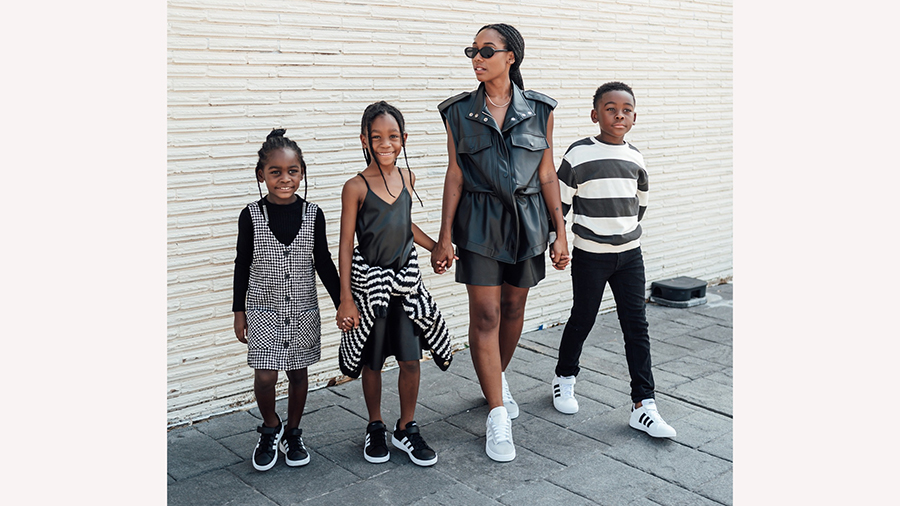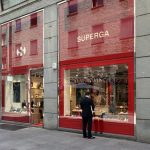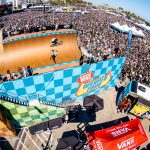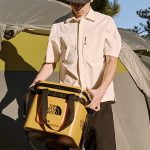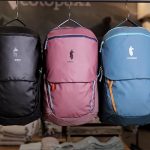Speaking at Caleres’ Investor Day event, Michael Edwards, president of Famous Footwear, said the family footwear chain plans to leverage its strong position in the kids’ category to meet its goal of making Famous “the destination for the Millennial family.”
Edwards pointed to Famous’ progress over the pandemic, with sales increasing 7 percent since 2019 despite 9 percent fewer stores. Brick & mortar sales are up 3 percent over that time period with the lower store count offset by sales per square foot and sales per store climbing 13 percent.
Famous’ digital business has increased 47 percent since 2019 and now represents 14 percent of total sales. While online penetration has moderated since the pandemic’s peak, “it’s still meaningfully above pre-pandemic levels and is becoming an essential component of our valuable omni business.”
Kids has been leading sales gains for Famous over the last three years.
Famous currently has 22 percent of the shoe chain market, up 1.2 percentage points from 2019. However, in kids, Famous has 28 percent of the market share within the shoe chain category, up 1.9 percentage points over since 2019. Edwards said, “We have plans in place to build on this strength and cement our leadership further.”
From a profitability standpoint, gross profit dollars at Famous are up $114 million since 2019, driven by a 500-basis point improvement in margin rates. Edwards said the margin improvement has been driven by less reliance on lower margin promo offers like BOGO, better inventory management to reduce the penetration of clearance product, and an increase in the assortment that’s excluded from deals. Today, more than 50 percent of Famous’ brands and styles are excluded from promotions.
Operating earnings are up 144 percent since 2019 with operating margins reaching 11.5 percent in 2022. Edwards said, “We expect another strong operating margin performance in 2023 and believe we can sustain high-single-digit operating margins over the next few years.”
Margins have been helped by a focus across Caleres on tightening inventory buys that have improved inventory turns at Famous by 7 percent versus pre-COVID levels.
At the same time, Famous is “getting behind key trends and brands in a big way,” employing an “Edit to Win” buying strategy “to make fewer bigger bets on the right items and brands,” according to Edwards.
As an example, he noted that this back-to-school season, Famous increased kids’ inventory by 24 percent year over year, “ensuring we could capitalize on this important demand season with the right brands and styles for our youngest consumers.”
Overall, Edwards attributes Famous’ recent success to a “relentless focus on our target consumer,” whom the chain internally has named “Christina,” a Millennial mom, with a strong link to her kids. Edwards said of Christina, “She wants to be able to shop anywhere at any time. She approaches every interaction with retailers and brands with the assumption that she’ll find relevant content and an easy shopping experience. Consumers like Christina spend more. They shop more often and they remain loyal over a longer period of time. When she shops at Famous for herself and her family, her value to us increases. Get her to shop both in-store and online, we see yet another escalation in her spend and her lifetime value.”
He added that Christina’s “primary purchase motivation” is her kids. He added, “Even when the family budget is under pressure, she prioritizes shopping for her kids and it’s a dynamic we’re clearly seeing this year.”
Currently, the kids’ business represents 21 percent of Famous’ sales although that penetration grows by 10 percentage points during the key back-to-school season. Including kids under 18 who are already wearing adult sizes, the kids’ business accounts for 30 percent of Famous’ sales.
“This year, our kids’ businesses are outperforming the total business by 10 percent compared to a year ago and continue to be a key differentiator and a top priority for us all year long,” said Edwards. “We are placing a great focus on this important business by making outsized investments in inventory to support the hottest brands and items and make sure we have exactly what our family shoppers are looking for.”
Beyond the inventory investment, Famous store employees are trained to service kids, “ensuring every child finds the perfect fit.” Remodels in the last few years have further prioritized an elevated experience within Famous’ Kids’ department.
Famous also stands out for its curated assortment of national brands across athletic and fashion categories. Edwards observed, “Christina and her family love brands, and Famous Footwear is known for our strategically cultivated assortment of iconic national brands. Put another way, there are no private label brands at Famous.”
The chain’s top brands represented 70 percent of sales in 2022, up from 64 percent in 2019. Edwards said, “Our top brands connect across the family from key athletic resources like Nike and Converse to premium fashion brands like Birkenstock and Doc Martens.”
Famous’ appeal also relates to convenience, including the chain’s omnichannel reach across its approximately 860 doors. About 55 percent of the U.S. population, or 70 million households, live within 10 miles of a Famous Footwear store.
Famous also continues to reimagine the in-store experience, including a new Flair prototype that includes “oversized, immersive pinwheel displays” showcasing new brands, emerging trends and seasonal offerings. In addition, digital displays “deliver energy and inspiration through sight, sound and motion and tech-enabled touchscreens allow consumers to browse more styles online and trigger an online purchase,” said Edwards.
The Flair concept has been tested and finetuned and the current prototype has been delivering a 5 percent lift.
Edwards said Famous will focus on four key brand strategies to drive market share gains:
- Kids: Edwards said kids “has become a key differentiator” and helps with the broader goal of driving higher annual spend, lifetime value, and higher self-purchase with its target Millennial mom customer. Edwards said, “We will drive this through product and content that connects with her emotionally and at the same time balancing for her and for her family.
- Enhanced brand assortments: Edwards said Famous is carrying more of “our best brands and most iconic styles from an inventory, a marketing and a store presence perspective.” The chain is working with vendor partners to add more premium products and looking to add new in-demand brands to the mix.
- Balance between athletic/non-athletic: Famous will be increasing its mix of fashion to achieve a 50/50 balance between fashion and athletic. This will enable Famous to be able to “flex into different categories. So, we are poised and ready to respond to what’s trending.” Broader assortments in categories like casual, dress and seasonal are also expected to resonate with the Famous Millennial Mom customer. The fashion emphasis also ties into Caleres’ broader strategy to increase vertical integration at Famous with Caleres’ in-house brands expected to expand to 10 percent of Famous’ sales by 2026, up from 6 percent currently. Caleres-owned brands and fashion brands overall tend to offer a higher margin rate for Famous.
- Omnichannel Engagement: Edwards said Famous will invest “to deliver a more engaging and inspiring experience across the omnichannel,” with those efforts supported store remodeling efforts. The new Flair format will expand from 11 currently to 20 later this year. The brand will also look to capitalize on engagement opportunities created by a new CDP (customer data platform) implemented in May.
Jennifer Olsen, Caleres’ chief marketing officer, said the company overall had 56 million customers in its database, largely from the Famously You rewards program that’s been around since 1996. Of Famous’ sales, 78 percent come from rewards members.
Olsen said the new CDP platform combines transaction data, website browser behavior, loyalty information, e-mail, and social engagement to provide one unified view of the consumer.
“All 56 million of them,” she added. ‘This first-party data is now clean. It’s structured, and it can be used in combination with predictive models powered by AI to do entirely new things, like finding the next generation of high-value consumers while simultaneously decreasing our customer acquisition costs. Reliably predicting which consumers are likely to take a specific action like buying from a new brand or new category at Famous Footwear and identifying the window in which a specific consumer is most likely to make another purchase or lapse so that we can intervene and take action and keep them shopping with us.”
As an example, she said a Famous back-to-school campaign this year used kids’ products in paid digital layering for the CDP platform’s benefit delivered 2 times the click-through rate and 2 times the return on ad spend on Meta (Facebook, Instagram) versus past methods of targeting moms with kids. On Google, a kid’s search campaign resulted in higher conversion and sales improvements of 14 percent.
A big push will be to get the Famous Millennial Mom customer to increasingly shop both in-store and online. At Famous, omnichannel shoppers spend two times more than those who shopped only online or only in-store. Olsen said, “We’ve already begun using the CDP and AI-driven predictive models to inspire her to shop for more members of the family, increase her purchase frequency, and keep her engaged with us over the longer term.”
On expansion, Caleres is not expecting to grow the Famous chain with openings expected to approximate closings. Edwards said Famous continues to look to upgrade locations within top DMAs (designated market areas). Nearly 50 percent of Famous’ store openings over the last three years have been relocations to improve real estate in key markets. Edwards added, “We also believe we have opportunity in under-penetrated markets like the Southeast and small urban markets or suburban and rural markets where we typically see higher profitability.”
Overall, Caleres’ three year-outlook from 2023 to 2026 calls for:
- Net sales to grow at a three-year CAGR of 3 percent to 5 percent;
- Adjusted EPS to increase at a three-year CAGR of 11 percent to 13 percent to reach $6.00 at the mid-point of the range; and
- Annual total shareholder return in low-to-mid-teens.
Jack Calandra, Caleres’ SVP and CFO, said the bulk of the sales and operating profit growth is expected to come from Caleres’ Brand Portfolio segment, powered by its four leadership brands: Sam Edelman, Vionic, Allen Edmonds, and Naturalizer.
The Branded Portfolio segment also includes Blowfish Malibu, Bzees, Circus NY, Dr. Scholl’s Shoes, Franco Sarto, LifeStride, Rykä, Veronica Beard, Vince, and Zodiac.
The Brand Portfolio is expected to generate 7 percent sales CAGR (compound annual growth rate) from 2023 to 2026. Operating margin in the Brand Portfolio segment is expected to reach 14 percent by 2026, up from this year’s forecast of about 11 percent. The improvement is expected to be driven by about 50 basis points of further gross margin expansion, with the remaining improvement from SG&A leverage.
Famous is expected to see more modest growth at about a 2 percent CAGR from 2023 to 2026, excluding the impact of the 53rd week in 2023. Operating margin is expected to remain flat versus this year’s forecast of about 8 percent. The higher sales are expected to come from gains in in-store productivity.
Caleres also reiterated its guidance for companywide sales for the third quarter and fiscal year 2023. However, given a shortfall in sales seen in September, it now expects sales to arrive at the low-end guidance for both third quarter and year.
Photo courtesy Famous Footwear

